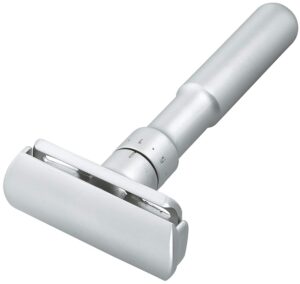Chrome-plated or solid stainless steel? That’s the question that could double your investment in a Rockwell razor and one that this Rockwell 6S review will question.
It goes without saying that both the 6S and 6C are excellent razors, thanks partly to their patented design of 3 separate combs to provide 6 different levels of aggression.
We constantly see is in shaving forums and groups that the two Rockwells are consistently recommended to beginners and expert wet shavers alike, moreso than classics like the Merkur 34C.
For us it is the Rockwell 6C that made our list of the best safety razors to own today for the simple reason of its low price.

Overall we would say that stainless steel razors are a bridge too far. A lot of modern razor startups like Supply and Rockwell give you the choice of stainless steel or nickel alloy for what is otherwise the same razor. OneBlade offer a variety of options from the plastic Oneblade Core to the premium OneBlade Genesis, via a hybrid that uses a plastic handle and steel head.
This is refreshing compared to a traditional razor manufacturer like Feather, who despite offering the best double edge razor blades and top of the range shavette razors, divide their safety razor offering between the cheap and cheerful Feather Popular and the expensive surgical stainless steel Feather AS-D2.
Nevertheless the choice of stainless steel or nickel alloy may be liberating but also challenging.
Stainless Steel Vs Alloy
Traditional safety razors are made from Zamak – a nickel alloy – which is then plated usually with chrome.
Often known as “pot metal” because as a widely-used material historically it was made by throwing scraps of various metals into a single crucible, Zamak is an alloy based on nickel, aluminium and copper. In fact the name is an acronym of those materials in German – Zink (zinc), Aluminium, Magnesium and Kupfer (copper).
One is that Zamak is quite a soft metal. Historically there wasn’t much quality control that went into it and so it is often associated with poor quality goods.
For instance, the central screw on a safety razor is crucial but safety razors are prone to being dropped. Plenty of safety razors meet their ends this way.
However, the quality of nickel alloy is not normally a problem with quality brands. We would definitely say that Rockwell falls into this camp of a high quality manufacturer with a devoted following, following from its origins on Kickstarter. The same might not be said of white-label brands who simply import razors from China and slap a logo on the box.
The next issue is of Chrome plating. Although relatively rare, over time lots of plated finishes do chip and wear away. That can create an uneven surface and tarnish the finish of the razor. Most Zamak razors can avoid this if they are cared for properly, but its fair to assume that a Rockwell 6C will start to show its age after a few years.
Stainless steel is much more durable. It is far more likely to survive being dropped and there’s no plating to worry about. Don’t be misled by online reviews that talk about steel razors going rusty (like this one from April 2019).
Stainless steel is just that – rust-proof. What happens in these cases is that a razor blade (which is not stainless steel) will leave rust stains of the inside of the head if it is left to corrode. In our experience a blade only stays in the razor for a couple of days with daily shaving and so any rusting of the blade normally occurs long after it has been removed and placed in either the blade box or a blade bank. If you do get rust stains on a stainless steel razor then you should be able to clean them off quite easily.
The Rockwell 6S takes stainless steel further by using a process called Metal Injection Moulding. This involves injecting powdered steel with a binder into the mould. The binder is then removed leaving the stainless steel behind. This is a precise method of metalworking normally reserved for medical and aerospace technology with very fine tolerances. The Supply Single Edge is also made this way.
Where Are The Rockwell 6S and 6C Made?
If the origin of a razor matters to you then the Rockwell 6S is made entirely in the USA. As for the 6C there is a widespread consensus that it is made in China.
The fact that Rockwell’s website clearly states the Rockwell 6S is made in the USA but does not say the same for the 6C is telling. Instead they use the marketer’s classic workaround that the 6C is “designed” in Canada – but not necessarily made there.
We’re therefore inclined to take the widespread view that the 6C is made in China. That’s no bad thing in terms of preformance providing a brand keeps a close relationship with the manufacturer. Vikings Blade razors are made in Asia as are Parker and they both produce excellent pieces.
Rockwell 6C vs 6S Performance
Other than the material there is very little that divides the two razors. The 6S has the Rockwell brand name on each side of the base plates whereas the chrome ones are blank.
Stainless steel means the Rockwell 6S feels much heavier – which is boosted by a very slightly wider handle. The 6C is about 100g while the 6S is around 120g.
That’s not a huge difference and shouldn’t have much of an impact on shaving. A lighter razor will often provide more feedback but equally a heavier razor can give you more of a feeling of control.








